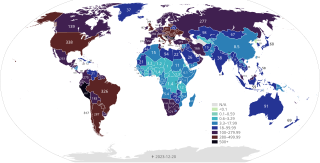Related Research Articles

A pandemic is an epidemic of an infectious disease that has spread across a large region, for instance multiple continents or worldwide, affecting a substantial number of individuals. Widespread endemic diseases with a stable number of infected individuals such as recurrences of seasonal influenza are generally excluded as they occur simultaneously in large regions of the globe rather than being spread worldwide.

The COVID-19 pandemic, also known as the coronavirus pandemic, is a global pandemic of coronavirus disease 2019 (COVID-19) caused by severe acute respiratory syndrome coronavirus 2 (SARS-CoV-2). The novel virus was first identified in an outbreak in the Chinese city of Wuhan in December 2019, and spread to other areas of Asia and then worldwide in early 2020. The World Health Organization (WHO) declared the outbreak a public health emergency of international concern (PHEIC) on 30 January 2020. The WHO ended its PHEIC declaration on 5 May 2023. As of 18 January 2024, the pandemic has caused 712,626,736 cases and 6,202,362 confirmed deaths, ranking it fifth in the list of the deadliest epidemics and pandemics in history.

This is a general overview and status of places affected by severe acute respiratory syndrome coronavirus 2 (SARS-CoV-2), the virus which causes coronavirus disease 2019 (COVID-19) and is responsible for the COVID-19 pandemic. The first human cases of COVID-19 were identified in Wuhan, the capital of the province of Hubei in China in December 2019.

The COVID-19 pandemic in mainland China is part of the worldwide pandemic of coronavirus disease 2019 (COVID-19) caused by severe acute respiratory syndrome coronavirus 2 (SARS-CoV-2). China was the first country to experience an outbreak of the disease, the first to impose drastic measures in response, and one of the first countries to bring the outbreak under control.

Coronavirus disease 2019 (COVID-19) is a contagious disease caused by the virus SARS-CoV-2. The first known case was identified in Wuhan, China, in December 2019. The disease quickly spread worldwide, resulting in the COVID-19 pandemic.

In the United States, the worldwide pandemic of coronavirus disease 2019 (COVID-19) caused by severe acute respiratory syndrome coronavirus 2 (SARS-CoV-2) has resulted in 103,436,829 confirmed cases with 1,161,235 all-time deaths, the most of any country, and the 20th-highest per capita worldwide. The COVID-19 pandemic ranks first on the list of disasters in the United States by death toll; it was the third-leading cause of death in the U.S. in 2020, behind heart disease and cancer. From 2019 to 2020, U.S. life expectancy dropped by 3 years for Hispanic and Latino Americans, 2.9 years for African Americans, and 1.2 years for white Americans. These effects persisted as U.S. deaths due to COVID-19 in 2021 exceeded those in 2020, and life expectancy continued to fall from 2020 to 2021.

The global COVID-19 pandemic arrived in Europe with its first confirmed case in Bordeaux, France, on 24 January 2020, and subsequently spread widely across the continent. By 17 March 2020, every country in Europe had confirmed a case, and all have reported at least one death, with the exception of Vatican City.

The COVID-19 pandemic in the United Kingdom is a part of the worldwide pandemic of coronavirus disease 2019 (COVID-19) caused by severe acute respiratory syndrome coronavirus 2 (SARS-CoV-2). In the United Kingdom, it has resulted in 24,863,166 confirmed cases, and is associated with 232,112 deaths.

A COVID‑19 vaccine is a vaccine intended to provide acquired immunity against severe acute respiratory syndrome coronavirus 2 (SARS-CoV-2), the virus that causes coronavirus disease 2019 (COVID‑19).

The World Health Organization (WHO) is a leading organisation involved in the global coordination for mitigating the COVID-19 pandemic within the broader United Nations response to the pandemic.

The COVID-19 pandemic has had many impacts on global health beyond those caused by the COVID-19 disease itself. It has led to a reduction in hospital visits for other reasons. There have been 38 per cent fewer hospital visits for heart attack symptoms in the United States and 40 per cent fewer in Spain. The head of cardiology at the University of Arizona said, "My worry is some of these people are dying at home because they're too scared to go to the hospital." There is also concern that people with strokes and appendicitis are not seeking timely treatment. Shortages of medical supplies have impacted people with various conditions.

Part of managing an infectious disease outbreak is trying to delay and decrease the epidemic peak, known as flattening the epidemic curve. This decreases the risk of health services being overwhelmed and provides more time for vaccines and treatments to be developed. Non-pharmaceutical interventions that may manage the outbreak include personal preventive measures such as hand hygiene, wearing face masks, and self-quarantine; community measures aimed at physical distancing such as closing schools and cancelling mass gathering events; community engagement to encourage acceptance and participation in such interventions; as well as environmental measures such surface cleaning. It has also been suggested that improving ventilation and managing exposure duration can reduce transmission.

As of 3 January 2024, 13.53 billion COVID-19 vaccine doses have been administered worldwide, with 70.6 percent of the global population having received at least one dose. While 4.19 million vaccines were then being administered daily, only 22.3 percent of people in low-income countries had received at least a first vaccine by September 2022, according to official reports from national health agencies, which are collated by Our World in Data.

SARS-CoV-2, the virus that causes COVID-19, was isolated in late 2019. Its genetic sequence was published on 11 January 2020, triggering an urgent international response to prepare for an outbreak and hasten the development of a preventive COVID-19 vaccine. Since 2020, vaccine development has been expedited via unprecedented collaboration in the multinational pharmaceutical industry and between governments. By June 2020, tens of billions of dollars were invested by corporations, governments, international health organizations, and university research groups to develop dozens of vaccine candidates and prepare for global vaccination programs to immunize against COVID‑19 infection. According to the Coalition for Epidemic Preparedness Innovations (CEPI), the geographic distribution of COVID‑19 vaccine development shows North American entities to have about 40% of the activity, compared to 30% in Asia and Australia, 26% in Europe, and a few projects in South America and Africa.

Martin Kulldorff is a Swedish biostatistician. He has been a professor of medicine at Harvard Medical School since 2003, though on leave as of 2023. He is a member of the US Food and Drug Administration's Drug Safety and Risk Management Advisory Committee and a former member of the Vaccine Safety Subgroup of the Advisory Committee on Immunization Practices at the US Centers for Disease Control and Prevention.

This article outlines the history of the COVID-19 pandemic in the United Kingdom. Though later reporting indicated that there may have been some cases dating from late 2019, COVID-19 was confirmed to be spreading in the UK by the end of January 2020. The country was initially relatively slow implementing restrictions but a legally enforced stay-at-home order had been introduced by late March. Restrictions were steadily eased across the UK in late spring and early summer that year.

The COVID-19 pandemic in China is part of the worldwide pandemic of coronavirus disease 2019 (COVID-19) caused by severe acute respiratory syndrome coronavirus 2 (SARS-CoV-2). China was the first country to experience an outbreak of the disease, the first to impose drastic measures in response, and one of the first countries to bring the outbreak under control.

COVID-19 is predicted to become an endemic disease by many experts. The observed behavior of SARS-CoV-2, the virus that causes COVID-19, suggests it is unlikely it will die out, and the lack of a COVID-19 vaccine that provides long-lasting immunity against infection means it cannot immediately be eradicated; thus, a future transition to an endemic phase appears probable. In an endemic phase, people would continue to become infected and ill, but in relatively stable numbers. Such a transition may take years or decades. Precisely what would constitute an endemic phase is contested.

The following is a timeline of the COVID-19 pandemic in the United Kingdom from July 2022 to December 2022.
The following is a timeline of the COVID-19 pandemic in the United Kingdom in 2023.
References
- 1 2 3 "How a little-known London start-up predicted China's deadly Covid outbreak". Telegraph UK. Sarah Newey. Retrieved 1 June 2023.
- ↑ "Why now is the time to stock up on UK small caps". FT Advisor. Ken Wotton and Tom Makey. Retrieved 3 February 2023.
- ↑ "AIRFINITY LIMITED - Company number 09502389". Find and update company information.
- 1 2 "Meet Europe's fastest-growing bootstrapped companies". Sifted. Maija Palmer and Riddhi Kanetkar. Retrieved 18 October 2021.
- ↑ "Companies in which the Future Fund has an equity interest". British Business Bank.
- ↑ "The World Tonight". BBC. Retrieved 27 June 2023.
- ↑ "UK Biological Security Strategy (HTML)". Government UK.
- ↑ "Which covid-19 vaccine saved the most lives in 2021?". Economist. Retrieved 13 July 2022.
- ↑ "Rapid-response manufacturing of adenovirus-vectored vaccines". Nature. Retrieved 8 March 2023.
- ↑ "China Centers for Disease Control and Prevention". National Health Commission (China).
- ↑ "China has stopped publishing daily COVID data amid reports of a huge spike in cases". NPR. Robbie Griffiths. Retrieved 25 December 2022.
- ↑ "China's 'zero-COVID' limits saved lives but no clear exit". AP News. Maria Cheng & Carla K. Johnson. Retrieved 29 November 2022.
- ↑ "Factbox: How many people might die, and why, under relaxed China COVID curbs". Reuters. Brenda Goh. Retrieved 20 December 2022.
- ↑ "Airfinity CEO Says Covid Peak Could Go Much Higher". Bloomberg. Retrieved 13 December 2022.
- ↑ "China Covid: experts estimate 9,000 deaths a day as US says it may sample wastewater from planes". The Guardian. Retrieved 30 December 2022.
- ↑ "China COVID deaths accelerate to 9,000 a day - UK research firm Airfinity". Reuters. Ryan Woo and Joe Cash. Retrieved 30 December 2022.
- ↑ "Rhodes Policy Summit: Creating a Positive Legacy from the Pandemic". The Rhodes Trust. Retrieved 14 April 2023.
- ↑ "Disease forecasters are convinced there's a 27% chance of another COVID-like pandemic within 10 years—but experts believe there's a silver bullet". Fortune. Eleanor Pringle. Retrieved 18 April 2023.